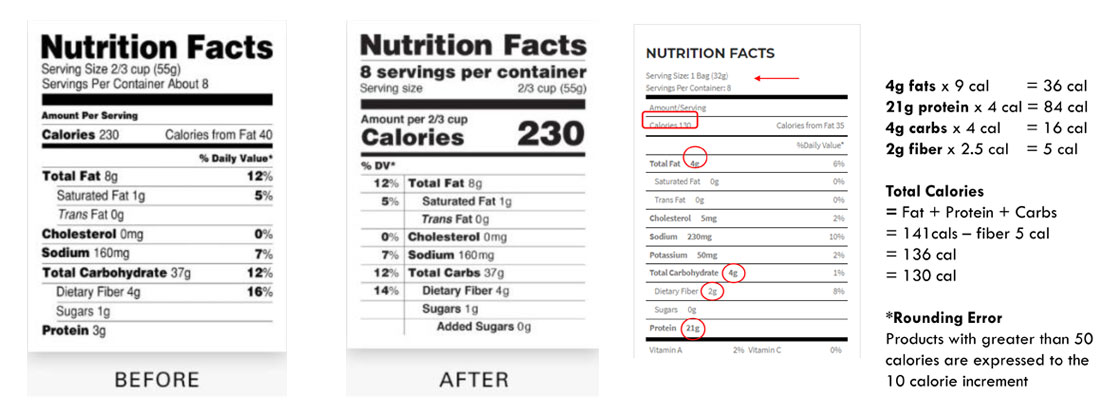Written by APD. Holly Baxter
October, 2017
What is dietary fiber?
Dietary Fiber is exactly as it reads, being the total amount of fiber found within a food.
What is total carbohydrate?
Exactly as it reads, total carbohydrate is the total amount of carbohydrate contained within a food, including dietary fiber.
What is net carbohydrate?
Net carbohydrate is the total amount of carbohydrate, minus the amount of dietary fiber found in a food and is often displayed on the front of food packaging. Essentially, this is a fancy way for food manufactures to market their food as being more superior than their competitors. For example, a protein bar manufacturer may make the claim that their product is more superior product as it contains only 5g net carbs, while their competitor may only be able to claim 15g net carbohydrate because their protein bar contains less carbohydrate from digestible carbohydrate sources (i.e. sugar) and a greater amount of dietary fiber.
Should we track dietary fiber as carbohydrate?
It is frequently assumed that dietary fiber contains zero calories. However, this is not an accurate statement. Dietary fiber typically yields ~2 calories per gram. Soluble fiber is thought to provide greater number of calories than insoluble fiber. This is due to its ability to be digested through a process of fermentation by our gut bacteria, which intern produces short chain fatty acids (SFA’s) which can be reabsorbed across the intestinal lumen and used as energy if required.
How much dietary fiber should you consume?
The daily value for fiber is 25g – 30g per day which is based on a 2,000 calorie diet. Depending on your nutritional requirements, your daily value may be higher or lower than this amount. Statistics show that most Americans only consume between10g – 15g per day.
What can be declared as dietary fiber?
Dietary fiber that can be declared on the nutrition information label includes certain naturally occurring fibers that are “intrinsic and intact” in plants, as well as added isolated or synthetic non-digestible soluble and insoluble carbohydrates. Anything considered to be non-dietary fiber must instead be declared in the total carbohydrate section of the nutrition panel.
A food manufacture can only list dietary fiber if they can scientifically demonstrate that the source of dietary fiber being used in their product has a physiological effect that is beneficial to human health.
An example of a positive physiological health benefit from dietary fiber in humans includes;
- Lowering blood glucose and cholesterol levels
- Lowering blood pressure
- Improved laxation and bowel function
- Increased mineral absorption in the intestinal tract
- Reduced energy intake (for example, due to the fiber promoting a feeling of fullness).
Other physiological endpoints could be added to the complete list if scientific evidence exists to support their inclusion.
Prior to the current definition of dietary fiber, the FDA regulations did not contain a definition of dietary fiber but rather relied on analytical methods for measuring levels of dietary fiber present in food. Therefore, an isolated or synthetic non-digestible carbohydrate could be added to foods and quantified as a dietary fiber even if it did not necessarily provide a beneficial physiological effect to human health. The rules have changed and there is now a definitive list of dietary fiber products that can be included in food products. The fibers listed below are the most common sources being added to food and can be declared on the Nutrition Facts label as dietary fiber.
FDA approved isolated and synthetic non-digestible carbohydrates
- Gum Acacia
- Alginate
- Apple Fiber
- Bamboo Fiber
- Carboxymethylcellulose
- Corn Hull Fiber
- Cottonseed Fiber
- Galactooligosaccharides
- Inulin/Oligofructose/Synthetic Short Chain Fructooligosaccharides
- Karaya Gum
- Oat Hull Fiber
- Pea Fiber
- Polydextrose
- Potato Fibers
- Pullulan
- Rice Bran Fiber
- High Amylose Corn/Maize Starch (Resistant Starch 2)
- Retrograded Corn Starch (Resistant Starch 3)
- Resistant Wheat and Maize Starch (Resistant Starch 4)
- Soluble Corn Fiber
- Soy Fiber
- Sugar Beet Fiber
- Sugar Cane Fiber
- Wheat Fiber
- Xanthan Gum
- Xylooligosaccharides
What is the difference between naturally occurring fiber and added fiber?
Naturally occurring fiber is sometimes referred to as “intrinsic” or “intact” fiber. This occurs in foods such as vegetables, whole grains, fruits, cereal bran, flaked cereal and flours.
Foods containing natural dietary fibers have been shown to be beneficial, and manufacturers do not need to demonstrate that they provide beneficial physiological effects to human health.
Only manufacturers using fibers that are added to foods, either by isolating them from other foods or synthesizing them, need to demonstrate a beneficial physiological effect to human health to meet the definition of “dietary fiber.”
Are their other types of fibers ?
In addition to naturally occurring fibers, the FDA has identified the following added non-digestible carbohydrates as meeting the dietary fiber definition:
- Beta-glucan soluble fiber
- Psyllium husk
- Cellulose
- Guar gum
- Pectin
- Locust bean gum
- Hydroxypropylmethylcellulose
How accurate is the dietary fiber amount listed on the nutrition information label?
The analytical methods used to determine the dietary fiber content of a food cannot distinguish the difference between types of non-digestible carbohydrates, therefore, food manufacturers must keep records for foods that contain dietary fibers which do comply with the regulatory definition of dietary fiber, along with added non-digestible carbohydrates that do not meet the definition of dietary fiber.
The amount of dietary fiber declared on a product label must however represent the amount of fiber that is quantified by analytical methods, minus the amount that does not meet the definition of dietary fiber.
A food manufacture is not permitted to declare any fiber type on the nutrition information panel that does not meet those which are recognized as having a positive physiological health benefit.
Complying with food labels
FDA recently ordered all food manufactures with an annual food sales exceeding the amount of $10 million, to comply with these new standards by July 26, 2018. For smaller businesses, the cutoff date was extended to July of 2019. However, a number of companies petitioned against this as they felt it was not only an expensive process to recall products with incorrect labels, they stated that it was simply not enough time to reformulate their products in order to make the same health claims. Evidently, FDA revoked the cutoff date and have not set a new date. Unfortunately, this means there are a number of mislabeled products still available for sale. There has not been a revised cutoff date for smaller food manufacturers to comply with the new labeling legislations.
If you are interested in learning more about dietary fiber and how it effects calories on food packaging labels, please refer to the articles page on my website https://hbnutrition.com.au/health-and-fitness-news/

Holly T. Baxter is an Australian Dietitian with over 13 years of experience in health and fitness. She holds a degree in Food Science and Nutrition and a Master of Dietetics from Deakin University. A former professional physique athlete, Holly has two World Championship titles. Her latest project, BiaBody, is dedicated to women’s health and fitness. As an APD Dietitian and Online Physique Coach, she focuses on evidence-based health education and empowering women through fitness.

